Liang Xiao
Generalizable Prompt Learning of CLIP: A Brief Overview
Mar 03, 2025


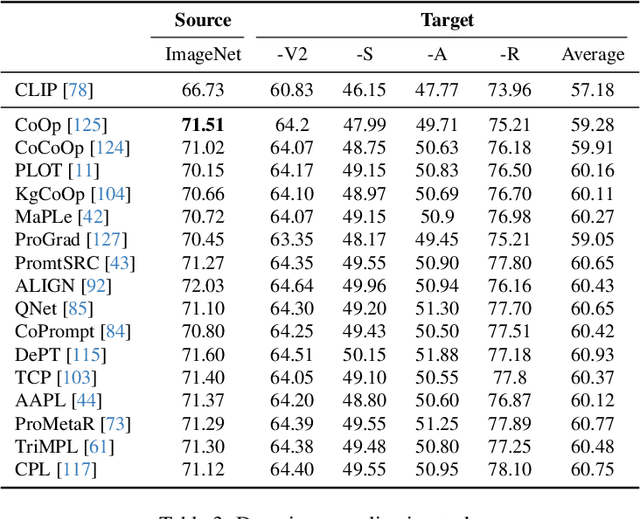
Abstract:Existing vision-language models (VLMs) such as CLIP have showcased an impressive capability to generalize well across various downstream tasks. These models leverage the synergy between visual and textual information, enabling them to understand and reason about the content present in images and text in a unified manner. This article provides a brief overview of CLIP based on few-shot prompt learning, including experimental data and technical characteristics of some methods. The purpose of this review is to provide a reference for researchers who have just started their research in generalizable prompting of CLIP through few-shot training for classification across 15 datasets and also to facilitate the integration of this field by researchers in other downstream tasks.
Retrieval-Augmented Generation by Evidence Retroactivity in LLMs
Jan 07, 2025Abstract:Retrieval-augmented generation has gained significant attention due to its ability to integrate relevant external knowledge, enhancing the accuracy and reliability of the LLMs' responses. Most of the existing methods apply a dynamic multiple retrieval-generating process, to address multi-hop complex questions by decomposing them into sub-problems. However, these methods rely on an unidirectional forward reasoning paradigm, where errors from insufficient reasoning steps or inherent flaws in current retrieval systems are irreversible, potentially derailing the entire reasoning chain. For the first time, this work introduces Retroactive Retrieval-Augmented Generation (RetroRAG), a novel framework to build a retroactive reasoning paradigm. RetroRAG revises and updates the evidence, redirecting the reasoning chain to the correct direction. RetroRAG constructs an evidence-collation-discovery framework to search, generate, and refine credible evidence. It synthesizes inferential evidence related to the key entities in the question from the existing source knowledge and formulates search queries to uncover additional information. As new evidence is found, RetroRAG continually updates and organizes this information, enhancing its ability to locate further necessary evidence. Paired with an Answerer to generate and evaluate outputs, RetroRAG is capable of refining its reasoning process iteratively until a reliable answer is obtained. Empirical evaluations show that RetroRAG significantly outperforms existing methods.
URoadNet: Dual Sparse Attentive U-Net for Multiscale Road Network Extraction
Dec 23, 2024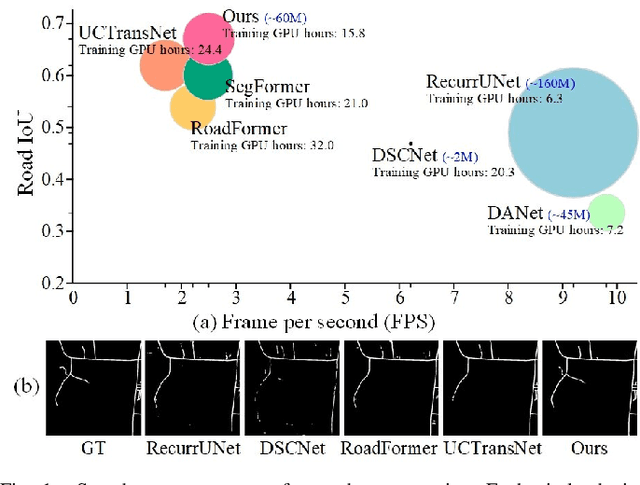
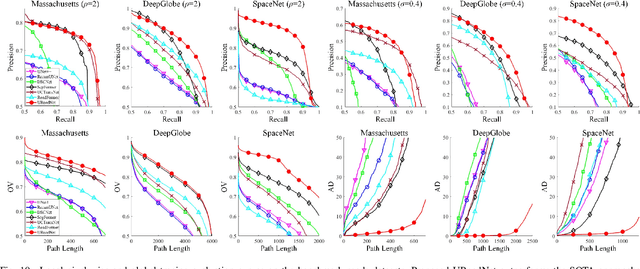
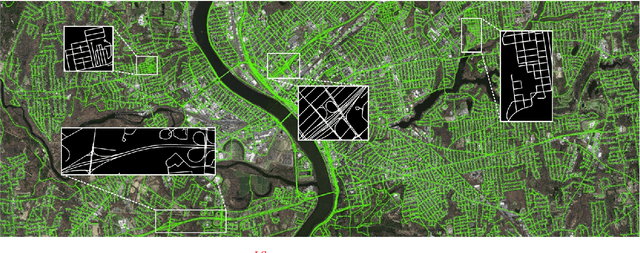
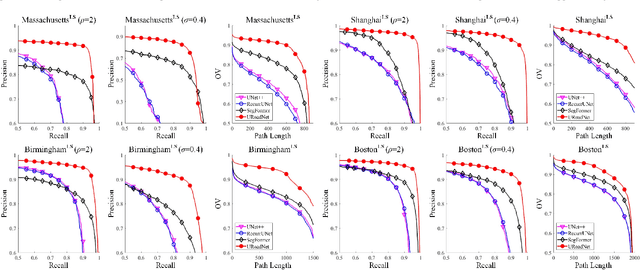
Abstract:The challenges of road network segmentation demand an algorithm capable of adapting to the sparse and irregular shapes, as well as the diverse context, which often leads traditional encoding-decoding methods and simple Transformer embeddings to failure. We introduce a computationally efficient and powerful framework for elegant road-aware segmentation. Our method, called URoadNet, effectively encodes fine-grained local road connectivity and holistic global topological semantics while decoding multiscale road network information. URoadNet offers a novel alternative to the U-Net architecture by integrating connectivity attention, which can exploit intra-road interactions across multi-level sampling features with reduced computational complexity. This local interaction serves as valuable prior information for learning global interactions between road networks and the background through another integrality attention mechanism. The two forms of sparse attention are arranged alternatively and complementarily, and trained jointly, resulting in performance improvements without significant increases in computational complexity. Extensive experiments on various datasets with different resolutions, including Massachusetts, DeepGlobe, SpaceNet, and Large-Scale remote sensing images, demonstrate that URoadNet outperforms state-of-the-art techniques. Our approach represents a significant advancement in the field of road network extraction, providing a computationally feasible solution that achieves high-quality segmentation results.
An End-to-End Robust Point Cloud Semantic Segmentation Network with Single-Step Conditional Diffusion Models
Nov 25, 2024



Abstract:Existing conditional Denoising Diffusion Probabilistic Models (DDPMs) with a Noise-Conditional Framework (NCF) remain challenging for 3D scene understanding tasks, as the complex geometric details in scenes increase the difficulty of fitting the gradients of the data distribution (the scores) from semantic labels. This also results in longer training and inference time for DDPMs compared to non-DDPMs. From a different perspective, we delve deeply into the model paradigm dominated by the Conditional Network. In this paper, we propose an end-to-end robust semantic \textbf{Seg}mentation \textbf{Net}work based on a \textbf{C}onditional-Noise Framework (CNF) of D\textbf{D}PMs, named \textbf{CDSegNet}. Specifically, CDSegNet models the Noise Network (NN) as a learnable noise-feature generator. This enables the Conditional Network (CN) to understand 3D scene semantics under multi-level feature perturbations, enhancing the generalization in unseen scenes. Meanwhile, benefiting from the noise system of DDPMs, CDSegNet exhibits strong noise and sparsity robustness in experiments. Moreover, thanks to CNF, CDSegNet can generate the semantic labels in a single-step inference like non-DDPMs, due to avoiding directly fitting the scores from semantic labels in the dominant network of CDSegNet. On public indoor and outdoor benchmarks, CDSegNet significantly outperforms existing methods, achieving state-of-the-art performance.
Autonomous Driving in Unstructured Environments: How Far Have We Come?
Oct 10, 2024
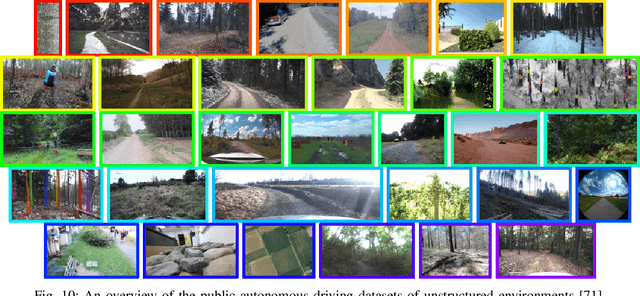
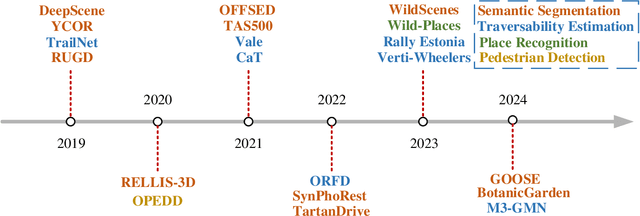
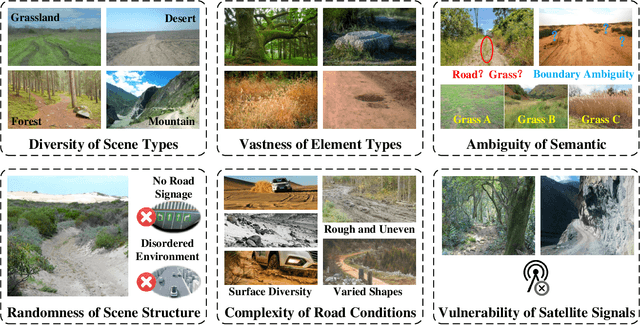
Abstract:Research on autonomous driving in unstructured outdoor environments is less advanced than in structured urban settings due to challenges like environmental diversities and scene complexity. These environments-such as rural areas and rugged terrains-pose unique obstacles that are not common in structured urban areas. Despite these difficulties, autonomous driving in unstructured outdoor environments is crucial for applications in agriculture, mining, and military operations. Our survey reviews over 250 papers for autonomous driving in unstructured outdoor environments, covering offline mapping, pose estimation, environmental perception, path planning, end-to-end autonomous driving, datasets, and relevant challenges. We also discuss emerging trends and future research directions. This review aims to consolidate knowledge and encourage further research for autonomous driving in unstructured environments. To support ongoing work, we maintain an active repository with up-to-date literature and open-source projects at: https://github.com/chaytonmin/Survey-Autonomous-Driving-in-Unstructured-Environments.
TSBP: Improving Object Detection in Histology Images via Test-time Self-guided Bounding-box Propagation
Sep 25, 2024



Abstract:A global threshold (e.g., 0.5) is often applied to determine which bounding boxes should be included in the final results for an object detection task. A higher threshold reduces false positives but may result in missing a significant portion of true positives. A lower threshold can increase detection recall but may also result in more false positives. Because of this, using a preset global threshold (e.g., 0.5) applied to all the bounding box candidates may lead to suboptimal solutions. In this paper, we propose a Test-time Self-guided Bounding-box Propagation (TSBP) method, leveraging Earth Mover's Distance (EMD) to enhance object detection in histology images. TSBP utilizes bounding boxes with high confidence to influence those with low confidence, leveraging visual similarities between them. This propagation mechanism enables bounding boxes to be selected in a controllable, explainable, and robust manner, which surpasses the effectiveness of using simple thresholds and uncertainty calibration methods. Importantly, TSBP does not necessitate additional labeled samples for model training or parameter estimation, unlike calibration methods. We conduct experiments on gland detection and cell detection tasks in histology images. The results show that our proposed TSBP significantly improves detection outcomes when working in conjunction with state-of-the-art deep learning-based detection networks. Compared to other methods such as uncertainty calibration, TSBP yields more robust and accurate object detection predictions while using no additional labeled samples. The code is available at https://github.com/jwhgdeu/TSBP.
Advancing Prompt Learning through an External Layer
Jul 29, 2024



Abstract:Prompt learning represents a promising method for adapting pre-trained visual-language models (VLMs) to various downstream tasks by learning a set of text embeddings. One challenge inherent to these methods is the poor generalization performance due to the invalidity of the learned text embeddings for unseen tasks. A straightforward approach to bridge this gap is to freeze the text embeddings in prompts, which results in a lack of capacity to adapt VLMs for downstream tasks. To address this dilemma, we proposeto introduce an External Layer (EnLa) of text branch and learnable visual embeddings of the visual branch for adapting VLMs to downstream tasks. The learnable external layer is built upon valid embeddings of pre-trained CLIP. This design considers the balance of learning capabilities between the two branches. To align the textual and visual features, we propose a novel two-pronged approach: i) we introduce the optimal transport as the discrepancy metric to align the vision and text modalities, and ii) we introducea novel strengthening feature to enhance the interaction between these two modalities. Extensive experiments show that our method performs favorably well on 4 types of representative tasks across 11 datasets compared to the existing prompt learning methods.
DriveWorld: 4D Pre-trained Scene Understanding via World Models for Autonomous Driving
May 07, 2024Abstract:Vision-centric autonomous driving has recently raised wide attention due to its lower cost. Pre-training is essential for extracting a universal representation. However, current vision-centric pre-training typically relies on either 2D or 3D pre-text tasks, overlooking the temporal characteristics of autonomous driving as a 4D scene understanding task. In this paper, we address this challenge by introducing a world model-based autonomous driving 4D representation learning framework, dubbed \emph{DriveWorld}, which is capable of pre-training from multi-camera driving videos in a spatio-temporal fashion. Specifically, we propose a Memory State-Space Model for spatio-temporal modelling, which consists of a Dynamic Memory Bank module for learning temporal-aware latent dynamics to predict future changes and a Static Scene Propagation module for learning spatial-aware latent statics to offer comprehensive scene contexts. We additionally introduce a Task Prompt to decouple task-aware features for various downstream tasks. The experiments demonstrate that DriveWorld delivers promising results on various autonomous driving tasks. When pre-trained with the OpenScene dataset, DriveWorld achieves a 7.5% increase in mAP for 3D object detection, a 3.0% increase in IoU for online mapping, a 5.0% increase in AMOTA for multi-object tracking, a 0.1m decrease in minADE for motion forecasting, a 3.0% increase in IoU for occupancy prediction, and a 0.34m reduction in average L2 error for planning.
Is Sora a World Simulator? A Comprehensive Survey on General World Models and Beyond
May 06, 2024Abstract:General world models represent a crucial pathway toward achieving Artificial General Intelligence (AGI), serving as the cornerstone for various applications ranging from virtual environments to decision-making systems. Recently, the emergence of the Sora model has attained significant attention due to its remarkable simulation capabilities, which exhibits an incipient comprehension of physical laws. In this survey, we embark on a comprehensive exploration of the latest advancements in world models. Our analysis navigates through the forefront of generative methodologies in video generation, where world models stand as pivotal constructs facilitating the synthesis of highly realistic visual content. Additionally, we scrutinize the burgeoning field of autonomous-driving world models, meticulously delineating their indispensable role in reshaping transportation and urban mobility. Furthermore, we delve into the intricacies inherent in world models deployed within autonomous agents, shedding light on their profound significance in enabling intelligent interactions within dynamic environmental contexts. At last, we examine challenges and limitations of world models, and discuss their potential future directions. We hope this survey can serve as a foundational reference for the research community and inspire continued innovation. This survey will be regularly updated at: https://github.com/GigaAI-research/General-World-Models-Survey.
CoSD: Collaborative Stance Detection with Contrastive Heterogeneous Topic Graph Learning
Apr 26, 2024Abstract:Stance detection seeks to identify the viewpoints of individuals either in favor or against a given target or a controversial topic. Current advanced neural models for stance detection typically employ fully parametric softmax classifiers. However, these methods suffer from several limitations, including lack of explainability, insensitivity to the latent data structure, and unimodality, which greatly restrict their performance and applications. To address these challenges, we present a novel collaborative stance detection framework called (CoSD) which leverages contrastive heterogeneous topic graph learning to learn topic-aware semantics and collaborative signals among texts, topics, and stance labels for enhancing stance detection. During training, we construct a heterogeneous graph to structurally organize texts and stances through implicit topics via employing latent Dirichlet allocation. We then perform contrastive graph learning to learn heterogeneous node representations, aggregating informative multi-hop collaborative signals via an elaborate Collaboration Propagation Aggregation (CPA) module. During inference, we introduce a hybrid similarity scoring module to enable the comprehensive incorporation of topic-aware semantics and collaborative signals for stance detection. Extensive experiments on two benchmark datasets demonstrate the state-of-the-art detection performance of CoSD, verifying the effectiveness and explainability of our collaborative framework.
 Add to Chrome
Add to Chrome Add to Firefox
Add to Firefox Add to Edge
Add to Edge